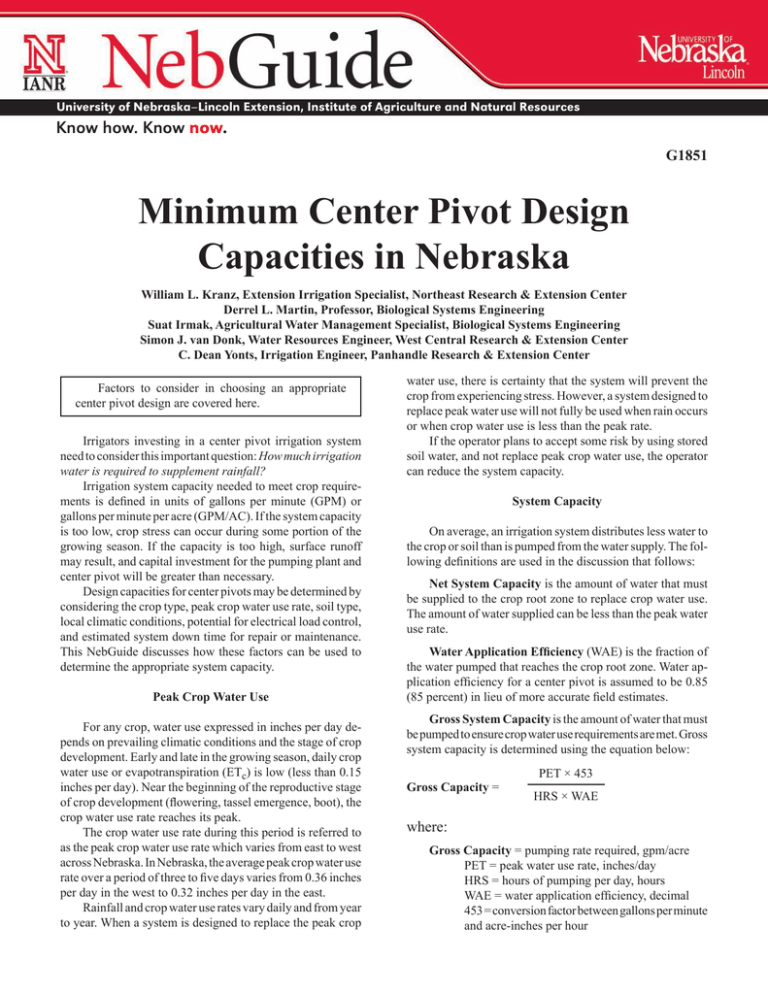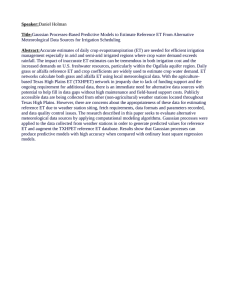
®
®
University of Nebraska–Lincoln Extension, Institute of Agriculture and Natural Resources
Know how. Know now.
G1851
Minimum Center Pivot Design
Capacities in Nebraska
William L. Kranz, Extension Irrigation Specialist, Northeast Research & Extension Center
Derrel L. Martin, Professor, Biological Systems Engineering
Suat Irmak, Agricultural Water Management Specialist, Biological Systems Engineering
Simon J. van Donk, Water Resources Engineer, West Central Research & Extension Center
C. Dean Yonts, Irrigation Engineer, Panhandle Research & Extension Center
Factors to consider in choosing an appropriate
center pivot design are covered here.
Irrigators investing in a center pivot irrigation system
need to consider this important question: How much irrigation
water is required to supplement rainfall?
Irrigation system capacity needed to meet crop requirements is defined in units of gallons per minute (GPM) or
gallons per minute per acre (GPM/AC). If the system capacity
is too low, crop stress can occur during some portion of the
growing season. If the capacity is too high, surface runoff
may result, and capital investment for the pumping plant and
center pivot will be greater than necessary.
Design capacities for center pivots may be determined by
considering the crop type, peak crop water use rate, soil type,
local climatic conditions, potential for electrical load control,
and estimated system down time for repair or maintenance.
This NebGuide discusses how these factors can be used to
determine the appropriate system capacity.
Peak Crop Water Use
For any crop, water use expressed in inches per day depends on prevailing climatic conditions and the stage of crop
development. Early and late in the growing season, daily crop
water use or evapotranspiration (ETc) is low (less than 0.15
inches per day). Near the beginning of the reproductive stage
of crop development (flowering, tassel emergence, boot), the
crop water use rate reaches its peak.
The crop water use rate during this period is referred to
as the peak crop water use rate which varies from east to west
across Nebraska. In Nebraska, the average peak crop water use
rate over a period of three to five days varies from 0.36 inches
per day in the west to 0.32 inches per day in the east.
Rainfall and crop water use rates vary daily and from year
to year. When a system is designed to replace the peak crop
water use, there is certainty that the system will prevent the
crop from experiencing stress. However, a system designed to
replace peak water use will not fully be used when rain occurs
or when crop water use is less than the peak rate.
If the operator plans to accept some risk by using stored
soil water, and not replace peak crop water use, the operator
can reduce the system capacity.
System Capacity
On average, an irrigation system distributes less water to
the crop or soil than is pumped from the water supply. The following definitions are used in the discussion that follows:
Net System Capacity is the amount of water that must
be supplied to the crop root zone to replace crop water use.
The amount of water supplied can be less than the peak water
use rate.
Water Application Efficiency (WAE) is the fraction of
the water pumped that reaches the crop root zone. Water application efficiency for a center pivot is assumed to be 0.85
(85 percent) in lieu of more accurate field estimates.
Gross System Capacity is the amount of water that must
be pumped to ensure crop water use requirements are met. Gross
system capacity is determined using the equation below:
PET × 453
Gross Capacity =
HRS × WAE
where:
Gross Capacity = pumping rate required, gpm/acre
PET = peak water use rate, inches/day
HRS = hours of pumping per day, hours
WAE = water application efficiency, decimal
453 = conversion factor between gallons per minute
and acre-inches per hour
Figure 1. Long term average annual rainfall amounts and the climatic regions for irrigation system capacity determination.
For example, if the peak crop water use rate were 0.32
inches per day and the pump operates 22 hours per day, the
gross system capacity would be (0.32 × 453)/(22 × 0.85) or
7.75 gallons per minute per acre irrigated.
Total pumping rate is determined by multiplying the
system capacity by the number of acres irrigated. For this
example a 130 acre center pivot requires a pump flow rate or
gross system capacity of 1,008 gallons per minute.
Table I.
Minimum net system capacities for the major soil texture
classifications and regions of Nebraska.
Soil Texture
Plant
Available Water
Capacity
(inch/ft)
Net Capacity*
9 of 10 years
Region 1
(gpm/ac)
Region 2
(gpm/ac)
PEAK ET**
5.65
6.60
Loam, silt loam very
fine sandy loam,
w/silt loam subsoil
2.5
3.85
4.62
Sandy clay loam Loam, silt loam very
fine sandy loam,
w/silty clay subsoil
2.0
4.13
4.89
Silty clay loam
Clay loam
Fine sandy loam
2.0
4.24
5.07
Silty clay
1.6
4.36
5.13
Clay
Sandy loam
1.4
4.48
5.19
Loamy sand
1.1
4.83
5.42
Fine sands
1.0
4.95
5.89
*Data taken from von Bernuth, R.D., D.L. Martin, J.R. Gilley
and D.G. Watts. 1984. Irrigation System Capacities for Corn Production in Nebraska. Transactions of ASAE 27(2): 419-424, 428.
**Net system capacity required to replace average peak water use rate.
Soil Water Holding Capacity
Net system capacities to replace 100 percent of crop
water use are presented in the top line of Table I. However,
net system capacity can be reduced by assuming some crop
water requirements are provided by stored soil water or rainfall
during peak crop water use periods. Accounting for stored
soil water and rainfall assumes that the irrigation system may
fall short of supplying crop water needs during years when
timely rainfall does not occur. If the net system capacity is
reduced, it is uncertain whether the system can prevent crop
stress from occurring.
Operators can assume some risk of crop stress to minimize the capital investment for the irrigation system (well,
pump, motor, pivot). One reasonable scenario is when the net
system capacity is adequate to ensure stress will not occur
nine years out of 10. The net system capacities required to
ensure that crop water needs are satisfied nine out of 10 years
are presented in Table I for different soil textures by region.
These capacities were developed from 20 years of rainfall
and crop water use records.
The plant available water capacity of a soil is an important aspect of irrigation system design. Plant available water
capacity is the maximum amount of water held in the soil that
the crop can use. To ensure that plant stress is minimized,
available water capacity should be maintained above the 50
percent available level.
A silty clay loam soil holds approximately 8 inches of
plant available water in a 4-foot profile, while fine sand holds
only 4 inches. The extra water stored in the silty clay loam
soil increases the amount of water available to the plant during peak water use periods, allowing the net system capacity
to be decreased. The primary soil textures found in Nebraska
and their associated plant available water capacities are listed
in Table I.
Environmental Factors
The location of the center pivot within the state also is
important. Rainfall varies by as much as 18 inches from east
to west across Nebraska (Figure 1). An irrigation system in
western Nebraska must be capable of supplying more water
during the growing season to account for the lower rainfall
amounts.
Other environmental factors that impact irrigation requirements are relative humidity and average wind speed. The
ability to evaporate water is usually less when air is humid
than when air is dry, and the ability to evaporate water usually
increases with increasing wind speeds.
Eastern Nebraska is more humid and less windy, meaning
less water will be evaporated from the soil and plant surfaces
than in western Nebraska. Thus, net system capacities can be
reduced in high humidity areas (e.g., growing season average
humidity >50 percent). Nebraska can be divided into two regions of differing environmental conditions, mainly rainfall,
as shown in Figure 1.
Because precipitation and other weather variables change
gradually as one moves across the state from east to west, it
would be impossible to provide enough columns in Table
I for each location. Thus, center pivot owners located near
the division line should interpolate between the two regions
to get a more accurate estimate of the minimum net system
capacity. For example, a center pivot with a silt loam soil
located in western Rock County should use a value of about
4.24 gpm/acre for the net system capacity [(3.85+4.62)/2) =
4.24 gpm/acre].
Repair and Maintenance
For irrigation systems to operate at a high efficiency,
maintenance must be performed. Maintenance can be done
only when the system is shut down, which also decreases total
operating time per week.
Even the best-maintained center pivot or pumping plant
eventually breaks down and requires repair of some part of the
system. These shutdowns further decrease the total pumping
time per week.
Electrical Load Control
Electrical load control occurs when the electrical power
supplier regulates the peak power use rate for the distribution
system by controlling power use by individuals during high use
periods. Irrigators can agree to have their power interrupted
in return for a reduction in power cost. The cost savings is
determined by the frequency that the electric power supply
can be interrupted.
The control period is generally from about 9:30 a.m. to
10 p.m., which allows power use between 10 p.m. and 9 a.m.
regardless of the type of control the user selects. Four types of
control are utilized by Nebraska Public Power Districts.
One day control is when the power cooperative is authorized to interrupt an irrigation system power supply for
one 12-hour period per week, on a predetermined day of the
week.
Two day control is similar, only with two 12-hour periods
of potential power interruption weekly.
Anytime control authorizes power districts to interrupt
power up to six 12-hour periods during a week, or about 40
percent of the time. Even though the power district may be
authorized to interrupt power 72 hours per week, field data
show that center pivots rarely are shut down more than 42
hours per week.
Hours per day control allows the power district to
interrupt power for a specified number of hours per day. In
this scenario, the power user agrees to let the power supply
be interrupted for four, six, eight, 10 or 12 hours per day on
Monday through Saturday.
Load control programs are aimed at reducing peak power
use rates, but the impact to the irrigation system is to reduce
water application time. If a system can be operated during only
part of the day, the water supply rate must be increased to meet
crop water needs. The multiplication factor for any number of
downtime hours can be determined using the equation:
Multiplier = ( 168 ) ÷ ( 168 – DT )
Where: DT = hours of downtime
For example, if the system was on two-day control, the
power could be interrupted for 24 hours so the multiplication
factor would be 1.17 ( 168/(168-24) ). The actual system capacity is determined by multiplying the system capacity with no
downtime by the multiplication factor (in our example: 7.75
gpm/acre x 1.17 = 9.07 gpm/acre).
Finding the Minimum Center Pivot System
Capacity Needed
The following example shows how to determine the gross
system capacity needed for a center pivot irrigation system
using Table I and Figure 1.
Example:
Determine the gross system capacity needed for a 130 acre
center pivot irrigation system located in Antelope County in
northeast Nebraska. The soils are primarily silty clay loams.
The operator has decided that replacing peak crop water use
rates nine years out of 10 is acceptable. The operator will enroll
the system in the two-day electric load control program, and
will need three hours per week for repair and maintenance.
Center Pivot System Capacity Worksheet
1.
2.
3.
4.
5.
6.
Select soil texture.
(Table I) Soil texture silty clay loam.
Select the region of the state. (Antelope County).
(Figure 1) Region number 1 (northeast)
Select the net system capacity opposite the soil texture in Table I.
(Table I) Net System capacity 4.24 gpm/acre
Assume the load control per week is 24 hours.
Assume that repair and maintenance down time is three hours per week.
Add the load control and repair and maintenance times together to obtain the total estimated down time per week.
24 hours + 3 hours = 27 hours of downtime
7. Calculate the multiplication factor for 27 hours (168 ) ÷ ( 168 - 27) = 1.19
8. Determine the total net system capacity by multiplying steps 3 and 7 together.
step 3
step 7
4.24 net gpm/acre ×
1.19
= 5.05 net gpm/acre
9. Determine the number of acres to be irrigated.
Area = 130 acres
10. Multiply the net system capacity (step 6) by the number acres (step 7) to determine the total net water supply rate needed for
the system.
×
step 9
= total system capacity
step 8
5.05net gpm/acre ×130 acres = 656 gallon per minute
11. Divide the total net water supply rate (step 10) by the application efficiency (use 0.85 percent for high pressure impacts; 90
percent for low pressure impacts; 92 percent for low pressure spray heads on top of the pipeline; and up to 95 percent for spray
heads on drop tubes at truss rod height).
step 10 ÷
Efficiency
656 gpm ÷ 0.85 = 772 gpm
This example shows the minimum water supply rate for a center pivot equipped with high pressure impact sprinklers should
be approximately 772 gallons per minute (656/0.85). The minimum system flow rate for a center pivot with low pressure spray
nozzles at truss rod height would be 690 gpm (656/0.95).
Summary
Determining the appropriate system capacity for a center
pivot is an important decision. Choosing a system capacity
that is too low can result in crop stress. Choosing a system
capacity that is too high results in an investment in a pump,
motor and other distribution system components that is greater
than necessary.
Using the water stored in the soil and rainfall that occurs
and making adjustments for system down time due to repair
and maintenance or load management modify the flow rate
that must be supplied to the center pivot. Taking these factors
into consideration assures the irrigation system has adequate
capacity to carry out the operator’s management scheme while
minimizing system ownership costs.
This publication has been peer reviewed.
UNL Extension publications are available online
at http://extension.unl.edu/publications.
Index: Irrigation Engineering
Irrigation Systems and Development
Extension is a Division of the Institute of Agriculture and Natural Resources at the University of Nebraska–Lincoln
cooperating with the Counties and the United States Department of Agriculture.
University of Nebraska–Lincoln Extension educational programs abide with the nondiscrimination policies
of the University of Nebraska–Lincoln and the United States Department of Agriculture.
© 2008, The Board of Regents of the University of Nebraska on behalf of the University of Nebraska–Lincoln Extension. All rights reserved.
Issued May 2008




